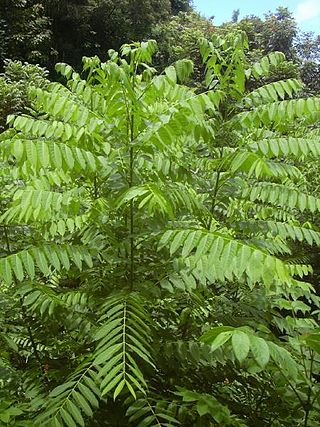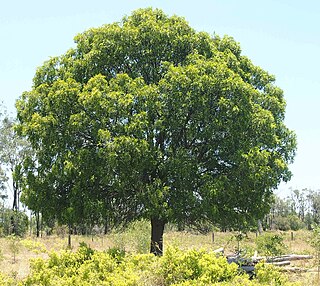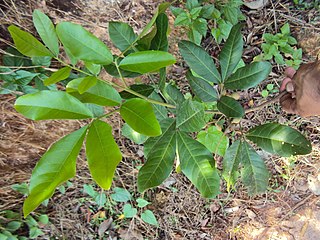
Meliaceae, the mahogany family, is a flowering plant family of mostly trees and shrubs in the order Sapindales.

Toona, commonly known as redcedar, toon or toona, tooni is a genus in the mahogany family, Meliaceae, native from Afghanistan south to India, and east to North Korea, Papua New Guinea and eastern Australia. In older texts, the genus was often incorporated within a wider circumscription of the related genus Cedrela, but that genus is now restricted to species from the Americas.

Cedrela is a genus of several species in the mahogany family, Meliaceae. They are evergreen or dry-season deciduous trees with pinnate leaves, native to the tropical and subtropical New World, from southern Mexico south to northern Argentina.

Melia azedarach, commonly known as the chinaberry tree, pride of India, bead-tree, Cape lilac, syringa berrytree, Persian lilac, Indian lilac, or white cedar, is a species of deciduous tree in the mahogany family, Meliaceae, that is native to Indomalaya and Australasia.

Azadirachta is a genus of two species of trees in the mahogany family Meliaceae. Numerous species have been proposed for the genus but only two are currently recognized, Azadirachta excelsa and the economically important tree Azadirachta indica, the neem tree, from which neem oil is extracted. Both species are native to the Indomalaysian region, and A. indica is also widely cultivated and naturalized outside its native range.

Carapa is a genus of flowering plants in the mahogany family, Meliaceae. These are trees up to 30 meters tall occurring in tropical South America, Central America, and Africa. Common names include andiroba and crabwood.

Entandrophragma cylindricum is a tree of the genus Entandrophragma of the family Meliaceae. It is commonly known as sapele or sapelli or sapele mahogany, as well as aboudikro, assi, and muyovu.

Entandrophragma is a genus of eleven known species of deciduous trees in the family Meliaceae.

Rosewood is any of a number of richly hued hardwoods, often brownish with darker veining, but found in other colours. It is hard, tough, strong, and dense. True rosewoods come from trees of the genus Dalbergia, but other woods are often called rosewood. Rosewood takes a high polish and is used for luxury furniture-making, flooring, musical instruments, and turnery.

Synoum is a monotypic genus of evergreen tree in the family Meliaceae. It is endemic to Australia where it is found along the eastern sub-tropical to tropical coast, usually on the margins of rainforests, in Queensland and New South Wales.

Owenia is a genus of plants, mainly trees in the family Meliaceae. They are dioecious, with male and female flowers on separate plants. They are endemic to Australia and fairly widespread across the continent. There are five species in the genus, living in conditions ranging from wet rainforest to the verges of the desert.

Aphanamixis polystachya, the pithraj tree, is a species of tree in the family Meliaceae. It is native to India, Pakistan, Nepal, Bhutan, Bangladesh, Myanmar and Sri Lanka. It is a widely used as a medicinal plant in Ayurveda.

Aglaia argentea is a species of plant in the family Meliaceae. It is a tree found in Australia, Brunei, India, Indonesia, Malaysia, Myanmar, Papua New Guinea, the Philippines, the Solomon Islands, and Thailand.

Aglaia elaeagnoidea, the droopy leaf or priyangu, is a species of plant in the family Meliaceae. It is a 10m tall tree found in American Samoa, Australia, Cambodia, China, India, Indonesia, Malaysia, New Caledonia, Papua New Guinea, the Philippines, Samoa, Sri Lanka, Taiwan, Thailand, Vanuatu, and Vietnam.
Aglaia laxiflora is a tree species in the family Meliaceae. It is native to Borneo, excluding the region that is the Malaysian state of Sarawak, an island located north of Australia at the geographic centre of Maritime Southeast Asia and is divided between the countries of Brunei Darussalam, Indonesia and Malaysia.

Lovoa trichilioides, also called African walnut, Congowood, dibetou or tigerwood, is a species of plant in the family Meliaceae. It is found in Angola, Cameroon, the Republic of the Congo, the Democratic Republic of the Congo, Ivory Coast, Gabon, Ghana, Liberia, Nigeria, Sierra Leone, Tanzania, and Uganda. It is threatened by habitat loss. Germination success is somewhat limited by short-lived seeds which are heavily predated. Exploitation rates are high. It is one of the two principal timber species in Congo.

Chisocheton is a genus of trees in the family Meliaceae. The genus name comes from the Greek schizos and chiton meaning "split tunic", referring to the lobed staminal tube of C. patens. Their range is from India and tropical China, throughout Malesia and south to New South Wales and Vanuatu.

Dysoxylum parasiticum, commonly known as yellow mahogany, is a species of rainforest tree in the family Meliaceae native to Taiwan, parts of Malesia, Papuasia, and northeast Queensland.

Cabralea is a genus of trees in the family Meliaceae. It has one species, Cabralea canjerana. It is dioecious, with male and female flowers on separate plants.
Chisocheton lasiocarpus is a species of tree in the genus Chisocheton of the Mahogany Family (Meliaceae). It is a sparsely branched, slightly buttressed, somewhat stout mesocaul or rather slender pachycaul tree of the western New Guinea rainforest rising to 110 feet in height, and possibly the only such tree with a weeping habit, the huge terminal rosettes of five foot long pinnate leaves of the lower branches facing down toward the earth. Like all Chisochetons, C. lasiocarpus has indeterminate leaves with a tiny circinate bud at the tip of each leaf which produces a new pair of leaflets every few weeks or months over a period of several years, each leaf eventually reaching five feet in length. There are 9 to 11 pairs of leaflets at a time. Each leaflet can be up to 18 inches long by up to nine inches in width. The flowers are white or pink, tubular, about a half inch long with 4 or 5 petals and 7 or 8 stamens. The tree is "myrmecophilous". C. lasiocarpus is a highly variable species.
















